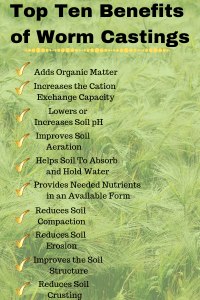What Does North Carolina Worms Do?
What Does North Carolina Worms Do?
Blog Article
Fascination About North Carolina Worms
Table of ContentsThe 25-Second Trick For North Carolina WormsSome Of North Carolina WormsThe 30-Second Trick For North Carolina WormsThe Ultimate Guide To North Carolina Worms
Instance: 1-gallon of worm castings to 4 gallons of potting mix. Do NOT make use of a potting mix that has chemical fertilizers in it. Review the labelit will claim. 1/2 cup in the base of the planting hole for smaller plants. 1 cup for bigger plants. ie. tomatoes, environment-friendly peppers, summer season squash, and so on.
The addition of tea can likewise add boosted microbial biomass to your dirt. You can always side-dress your plants with worm castings any time. Just remember, the microbes will certainly die if subjected to UV rays (Sunlight), so make certain to cover the spreadings with an inch approximately of soil.
This frustrated them for years up until the screening techniques came to be better. It would certainly get much better(with even more castings), degree off, and after that decrease. Too several worm spreadings would increase the growth to a rate that the plant could not recoup from.
The Only Guide to North Carolina Worms
I have expounded the virtues of worm spreadings for concerning 2000 words. Worm castings are no various. It takes time to create high quality worm spreadings.
You can purchase them which causes number two. Worm spreadings certainly set you back more than chemical plant foods. However, worm castings get on the less costly end of natural plant foods. You will need to determine what is more crucial. It is simple to produce small amounts of worm spreadings. (50 gallons annually) It is a much more challenging and extremely expensive financial investment to generate big amounts of worm castings (Lake Hickory Bait).

Producing a healthy dirt may be the best advantage of worm spreadings. We went over worm spreadings NPK and likewise the proper nutrient evaluation that ought to use to worm castings.
The 7-Minute Rule for North Carolina Worms
We talked concerning some of the downsides connected with worm castings. I covered a whole lot of material in this write-up.
The upright burrows are commonly open, although the worms top the leading with residue and waste matter. Origins need oxygen for their growth, whereas they create carbon dioxide that needs to leave the soil.
Earthworms increase porosity by two devices: (1) by developing long-term burrows, and (2) by enhancing soil aggregation. Gathering is enhanced by the mixing of dirt and organic issue in the earthworms' digestive tracts. Where to buy worms in NC. These highly stable aggregates are deposited by some earthworms in their burrows, and by others at the surface area of the soil


In one more research, earthworms were estimated to take in 4 to 10 percent of the top 6 inches of the soil every year. Soil compaction lowers the porosity of the soil.
4 Simple Techniques For North Carolina Worms
Common earthworm populaces can quickly eat 2 loads of completely dry matter per acre annually, partly absorbing and mixing it with dirt. The importance of earthworms to blend surface deposit with dirt becomes really clear in dirts that do not have any earthworms. The majority of our Pennsylvania dirts contend the very least some earthworms, and the impact of their full absence, therefore, can not be noted.
(https://supplyautonomy.com/northcarolinaworms.us)In these dirts, the formation of topsoil with affordable organic matter content did not take place, causing bad plant growth. When the cause was developed, the government of the Netherlands began a project to introduce earthworms. After the introduction of the earthworms, a dark topsoil layer was created, and crop development raised substantially.
They live mostly from partly broken down natural issue that is currently included in the dirt. They eat their way via the soil, producing horizontal burrows that they fill with their excrement. These varieties ingest big amounts of dirt that they blend with digested crop deposit in their intestines. or anecic varieties stay in irreversible upright burrows that can be 5 or 6 feet deep.
Their burrows continue to be open, although they top the top with crop deposit that they pull to the entrance. These varieties consume considerable amounts of dirt that they blend with digested deposit in their intestines. Their waste matter is mostly deposited at the surface of the soil. The nightcrawler Lumbricus terrestris is the most famous participant of this team.
Report this page